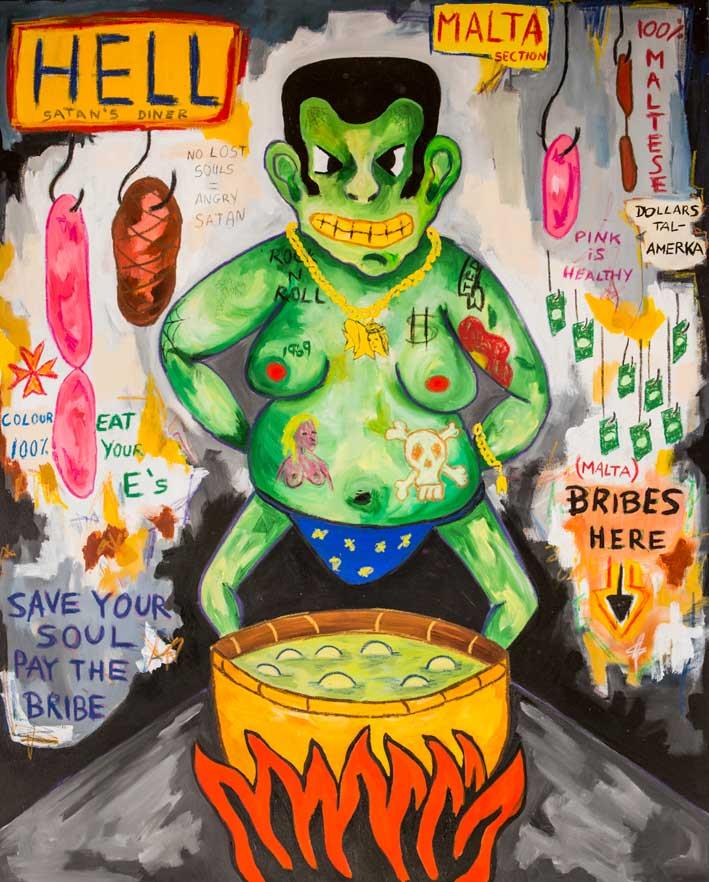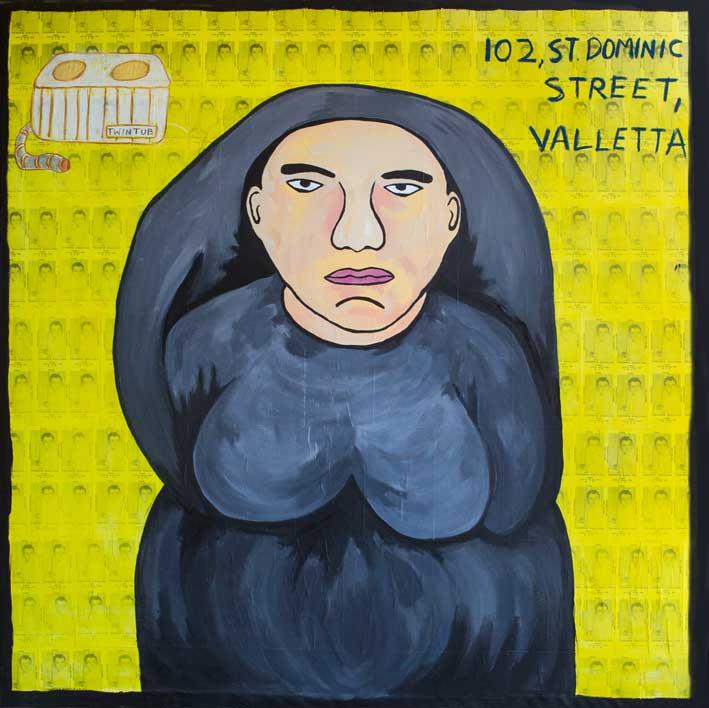Ryan Falzon's recent exhibition We Lost the War, curated by Michael Fenech, consisted of chaotic canvases presented against the pristine white walls of Spazzju Kreattiv. Every picture was loaded with motifs and text that accentuated the narrative around the subject matter, mainly mafia personages and criminals. Violence, corruption, debauchery, superstition, ignorance. Every painting felt like a dead end salvaged only by their satirical veneer. Laughter, it seemed, was the only way out of the reality they portrayed.
Ryan envisioned his preoccupation with loss and conflict as grotesque cartoon-like renditions of familiar characters and pop cultural references of both local and international ancestry. His objective was to represent an accumulation of images that reflected his perception of the problems embedded in contemporary society. An absurd situation necessitates distorted imagery. In Ryan's own words, his paintings "try to convey what I see and what I feel to be truthful". They are not beautiful, yet they do aim to project social truths that expose the underbelly of human nature.

Still, should social ugliness be fought with painterly ugliness even if the former is true? There is, as Ryan says, beauty in depicting the world sincerely. Numerous artists, amongst them Goya, Picasso, Bacon and Grosz, deformed the representation of reality for their art to reflect the troubling circumstances of their particular time. The Maltese Josef Kalleya and Carmelo Mangion repudiated the standards of beauty upheld by their contemporaries, and in doing so both succeeded in defining the experience of modernity whilst many others resisted the inevitability of progress.
Art that deliberately challenges the idea of beauty has the potential to be revelatory and deeply familiar. I found Ryan's paintings to be expressions of sentiments often felt when reading the news or scrolling through Facebook. Despite my characteristic optimism, it is impossible to not feel saddened, frustrated and disturbed by the world we live in. This is what made Ryan's disordered images perturbingly appealing; they crudely visualised a society driven by materialism and cheap thrills.
Loss was heavily emphasised; loss of ideals, loss of values, loss of integrity. Yet at no point did Ryan project any sense of nostalgia or sentiment for a past mode of being. A couple of years ago, my doctoral supervisor Dr. Giuseppe Schembri Bonaci delivered a paper on the romanticisation of lost time in the poetry of Dun Karm and the paintings of Edward Caruana Dingli. Both projected a longing for an idyll that had been abolished (according to their art) by modernity; Dun Karm's yearning for childhood innocence contrasted with Caruana Dingli's superficial glorifications of rural existence. None of this is present in Ryan's paintings. They are very matter of fact, and offer the viewer no way out of the misery they behold.
They recalled Juan Mamo's Ulied In-Nanna Venut Fl-Amerka and Giorgio Preca's 1950s folk scenes. Both Mamo and Preca portrayed the superstition and ignorance of the Maltese people in a comical manner that is laced with bitterness.
As said by Ryan; "I loathe the creation of icons that celebrate unreal ideals of a long gone past, a classic example being all this 'current' hype about te in a dirty tazza with some greasy pastizzi that supposedly represent root elements of our identity. Just like Mamo and Preca, I do not use dark humour and rhetorical questions because I hate for my country, but more because there is a strong will to show how certain issues are of concern for the inhabitants. I want my art to be relevant and reflect the time and place it is created in."

I agree with Ryan that there is a scarcity of political visual art in Malta. His language of communication is very direct and unrefined. The political message of his pictures is explicit and his penchant for the grotesque is a recurrent quality. Readability, however, is not the defining feature that makes art political. I find this to be a common misconception in Malta; we are obsessed with likeness and figuration over and above aesthetic questions. I do think that Ryan addresses this problem in his disfiguring of the human body.
When asked about the relevance of painting today and its potential to be political, especially with more and more artists opting for digital media, Ryan's response was decidedly resolute; "Painting is as relevant as ever today. My work is all about juxtaposing elements which I deem relevant for the creation of a new visual landscape. An important part of painting is what the viewer brings to it. The viewer needs to engage with the artwork. For such purposes, painting is the best vehicle. I paint for different reasons. I like the kick of creating visuals that speak to people. I get a basic instinctive thrill. There is a huge debate in the art world today - which has been going on for quite some time - on whether painting is alive or nearing a natural death. All over the world there has been a resurgence of painting and a greater appreciation of the painter as a generator and creator of powerful images."
I very much agree with Ryan on this. Painting gives artists infinite possibilities for the re-presentation and manipulation of the object-world. It allows us to add to the repository of visual content that is embedded in our collective memory. As a tactile medium, painting permits the conveyance of artistic individuality in a way that is tangible. This quality allowed me to identify with Ryan's personal feelings towards a situation in which we are all implicated. This does not mean that other media are any less human, far from it, but painting does have this advantage which I believe is rather necessary in a globalised world of increasing alienation and bureaucratisation.
And it is for this reason that I would criticise his choice of exhibition space. The sterile walls of Spazzju Kreattiv do have this tendency to neutralise the subversive potential of art despite the strength of the images themselves. I cannot blame Ryan for wanting to show his works in a prominent institution, but maybe we need to be more critical of spaces and institutions, especially with the relegation of artistic value to statistics and paperwork.
But who lost what war? "I lost the war, you lost the war, we all lost the war." So where does art go from here? How are things to change, or can they even be changed, as Ryan's fatalistic attitude suggests? Is there really, as Adorno argues, no poetry after Auschwitz? We need art that is political, subversive, critical, and liberated from sentimental frills. Some artists like Ryan have taken this direction. Thankfully, not all battles are lost.
Photographs: Elisa von Brockdorff